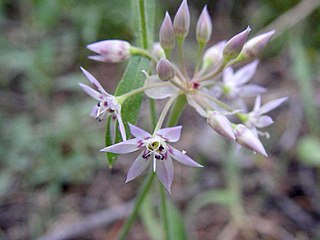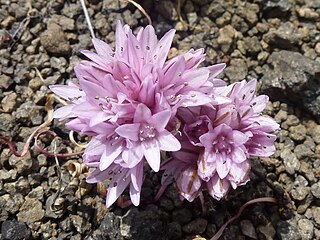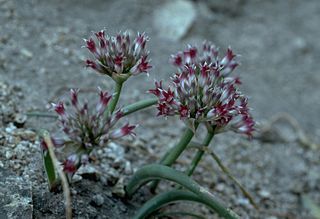
Allium validum, known by several common names including swamp onion, wild onion, Pacific onion, and Pacific mountain onion, is native to the Cascade Range, to the Sierra Nevada, the Rocky Mountains, and other high-elevation regions in California, Oregon, Washington, Nevada, Idaho and British Columbia. It is a perennial herb and grows in swampy meadows at medium and high elevations.

Allium acuminatum, also known as the tapertip onion or Hooker's onion, is a species in the genus Allium native to North America.

Allium crispum is a species of wild onion known by the common name crinkled onion. It is endemic to California, where it grows along the Central Coast in the Coast Ranges and in the Santa Monica Mountains, often in clays and serpentine soils. It is a perennial herb that is typically found in the foothill woodlands and valley grasslands of California.

Allium haematochiton is a North American species of wild onion known by the common name redskin onion. It is native to northern Baja California, Sonora, and southern California as far north as Kern County. It grows on the slopes of the hills and mountains, such as those of the Peninsular Ranges, Transverse Ranges, and southern California Coast Ranges.

Allium amplectens, the narrowleaf onion, is a species of onion plant. It is native to the West coast of the United States, in Oregon, Washington State and California, also British Columbia in Canada. It grows in woods and especially in clay and serpentine soils.

Allium campanulatum is a species of wild onion known by the common name dusky onion or Sierra onion. This is a flowering plant native to the western United States from southeastern Washington and northern Oregon to southern California, and western Nevada. The dusky onion grows in foothills and mountains, especially in dry areas, such as chaparral habitats.

Allium dichlamydeum is a species of wild onion known by the common name coastal onion. It is endemic to California where it grows on sea cliffs and hills overlooking the ocean, from Santa Barbara County to Mendocino County.

Allium obtusum is a species of wild onion known by the common name red Sierra onion or subalpine onion. It is native to eastern California and western Nevada. It is a common plant in the granite foothills and mountains of the Sierra Nevada and southern Cascade Range, from Tulare County to Siskiyou County, from elevations of 800 to 3,500 metres. In Nevada, it is reported only from Washoe County in the northwestern part of the state.

Allium parvum is an American species of wild onion known by the common name small onion. It is native to the western United States where it is a common member of the flora in rocky, dry areas in mountainous areas, especially in talus at elevations of 1,200–2,800 m (3,900–9,200 ft). It is widespread in California, Nevada, Oregon and Idaho, and also reported from western Utah and from extreme southwestern Montana

Allium platycaule is a species of wild onion known as broadstemmed onion or flat-stem onion. It is native to northeastern California, south-central Oregon and northwestern Nevada. It is found on slopes of elevations of 1500–2500 m.

Allium burlewii is a species of wild onion known by the common name Burlew's onion. It is endemic to California, where grows in the granitic soils of several of the central and southern mountain ranges from Riverside and San Bernardino to Fresno and Monterey Counties, usually between 6,000 and 10,000 feet above sea level.

Allium denticulatum is a species of wild onion known by the common name toothed wild onion. It is endemic to southern California, where it grows in the western Mojave Desert, the adjacent Tehachapi Mountains, the southern Sierra Nevada, and the Palomar Mountains. It is reported from Kern, San Bernardino, Riverside, Ventura, San Diego Counties.
Allium diabolense, common name serpentine onion or devil's onion is a species of wild onion endemic to central California, where it is known from the Coast Ranges and the Transverse Ranges. It grows on serpentine soils at elevations from 500 to 1500 m, from Kern and Ventura Counties north to Stanislaus and Santa Clara Counties.

Allium hickmanii is a rare species of wild onion known by the common name Hickman's onion. It is endemic to California, where it is known from Monterey, Sonoma, Kern, and San Luis Obispo Counties.

Allium howellii is a North American species of wild onion known by the common name Howell's onion. It is endemic to California.

Allium monticola is an uncommon species of wild onion known by the common name San Bernardino Mountain onion. It is endemic to southern California, where it is found in the Transverse Ranges and the northernmost section of the Peninsular Ranges. It has been reported from San Bernardino, Los Angeles, Orange, Ventura and Santa Barbara Counties.

Allium parishii is an uncommon species of wild onion known by the common name Parish's onion. It is native to the Mojave Desert and Sonoran Deserts of California and Arizona. It grows on open dry, rocky slopes at elevations of 900–1,400 m (3,000–4,600 ft).

Allium praecox is a species of wild onion known by the common name early onion.
Allium punctum is a species of wild onion known by the common name dotted onion or Modoc onion. It is native to the western United States in and around the Modoc Plateau in northeastern California, northwestern Nevada, and southeastern Oregon. It is uncommon, growing in volcanic flatlands created by old lava flows.

Allium siskiyouense is a North American species of wild onion known by the common name Siskiyou onion. It is native to the Klamath Mountains and nearby ranges of northern California and Oregon. It grows in serpentine and other rocky soil types.




















